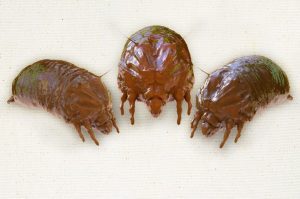Identification and Life Cycle
The Bird mite (Ornithonyssus bursa), and the Rodent mite are both insect-like organisms, some which bite or can cause irritation to humans.
The Bird Mite is so small, it’s barely visible to the eye. The adult, almost transparent, has eight legs, an oval shaped, flat body with few short hairs. These parasites feed on living organisms and the females need blood in order to reproduce. They have piercing mouthparts that enable them to take blood from their bird hosts, and once they digest blood, they may appear reddish to dark brownish in color. Mite eggs are white, oval and cannot be seen without magnification.
The mite has five stages; egg, larva, rotonymph, deutonymph and adult. Most bird mite species can complete development in 5 to 12 days within preferred temperatures and a host.
The Rodent Mite, although it is very small in size, can be seen with the naked eye, and may appear to be a slow-moving red and grey spec. The adults have oval shaped bodies, four pairs of legs, no antennae, and mouthparts grouped in front of the body. It has four stages; egg, larva, nymph and adult. The life cylce usually takes from 10 to 12 days to complete.



Comments are closed.